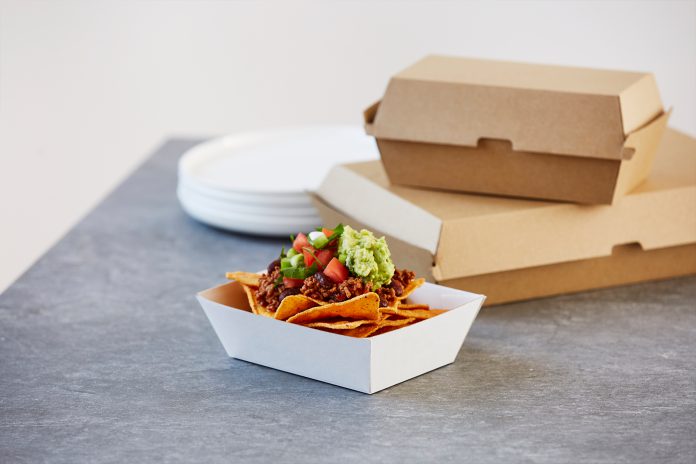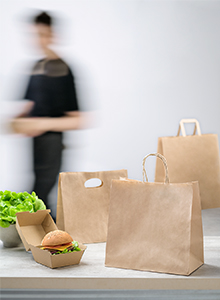
The popularity of food delivery continues to grow – with the global revenue growth rate anticipated to remain high at 9.9% per year until 2023. Tech-savvy, time-poor Millennial-era customers are driving demand [1]. Eating food outside of restaurants is no longer merely about convenience, it is becoming a luxury, and people are willing to pay a premium for a quality experience and restaurants need to deliver. Once food leaves the kitchen, the right packaging solution is a restaurant’s best chance at protecting food integrity. It means chefs can have more control over the out-of-restaurant dining experience, and provide the level of service customers expect. Packaging needs to be cost-effective, functional, and easy to use both in-store and at home. Whether your business handles just a few delivery orders a week, or it is a significant portion of income, the packaging experts at Detpak can deliver packaging solutions to meet your needs.
We caught up with food delivery experts, Detpak, who have put together this guide of tips and tricks for restaurants wanting to reignite or refresh their offering.
#1 Preparing your menu for the journey home
Determine which menu items will be offered for food delivery. A pared-down menu featuring items that will not be impacted by the delivery process means customers won’t receive food in poor condition. From this, carefully consider which packaging items will be needed. Remember, the packaging is the first impression the customer will get of your food.
#2 Sustainable packaging
Sustainable packaging is a way you can demonstrate to your customers your commitment to the environment. And with localised plastic bag bans and ongoing efforts from governments and organisations to eliminate problematic, single-use plastics, is it worth being aware of how legislation may impact your packaging choices. Using recyclable, reusable or compostable packaging can help give your business an advantage. It can also help change the opinion that ordering food for delivery is wasteful.
#3 Branding means business
Packaging is one of the best value forms of communicating with your audience: your customer.Your packaging is the first look your customers get at your brand when they open their food delivery bag. You’ve got a captive audience, so take the chance to send a message about your brand. Simple solutions, like stickers and stamps add easy branding or messaging, and can helprecreate the mood of the restaurant at home.
#4 Value for money
How much business do you expect to get from food delivery? What investment are you making to ensure the integrity of both the food and your brand? Consider cost-effective options like products that serve dual purposes (e.g. a bowl that can be used for soup or sauce). To be sure you’re getting the most out of your packaging investment, choose items available in smaller quantities, and/or are flat-packed for neater, more compact storage.

#5 Perfect the presentation and educate staff
Use packaging samples to check how your food sits in it, ensure it won’t move during transport, and will protect product integrity. Effective packaging solutions should be simple for everyone to use. Make sure all staff who will be handling food know how to package it up.
#6 Give something extra to gain an edge
To delight your customers, elevate their delivery experience with something extra. Perhaps include an after dinner mint, a personal message from the chef, or even more information about your food. Other things to consider include space for scrap disposal – for example, chicken wings or ribs can be messy, so make sure cleanup is easy.
#7 Protect food integrity
When the delivery arrives at its destination, you need to be confident the packaging will have done its job. Packaging should fit to the food, not the other way around. Hot food: If it’s fried and crispy, the packaging should withstand grease, retain heat and resist sogginess. Packaging may need to be lined with a wrap for extra grease resistance. The packaging may need ventilation holes, or be made from breathable materials. Packaging with a foodsafe polyethylene lining will keep sauces and dressings intact – and means the packaging won’t go soft. Cold food: If delicate items like cold rolls and sushi will be on the delivery menu, then polyethylene-lined packaging will protect the food and prevent grease stains. If the packaging will be chilled, ensure it’s freezer safe. Eating: Will customers be eating straight from the packaging, and can they do this easily? Flatter, wider packaging allows for better “plating up” to show off the beautiful ingredients, and is much easier to eat from.
#8 The delivery experience is an extension of the restaurant
Look at the delivery through the customer’s eyes. What is their impression of your brand and business? The delivery experience must be good enough that the customer feels it’s worthwhile, and an equivalent experience to going to the restaurant. Messy, unappealing packaging can create an image of unappealing food – you don’t want people thinking “what did I just spend $50 on?” You want them to remember their experience with you fondly, and know they’ll be encouraged to order again. Packaging is your first and last chance to send a message about what your restaurant stands for.
[1] Beyond Takeout: Restaurant Delivery and the Future of Home Delivery in Foodservice: http://blog.euromonitor.com/2016/07/ beyond-takeout-restaurant-delivery-and-the-future-of-home-delivery-in-foodservice.html











